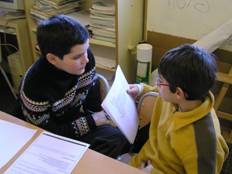
Educational sciences have of late emphasized the importance of interaction as a main ingredient responsible for learning. Interaction with others opens up cognitive conflicts which lead to learning. It is though interaction between new knowledge and the teacher (mediator) that we learn. But we also know that in given circumstances the same students can act as mediators. We have all learned from school or work peers. Some authors claim that, sometimes, students can be better mediators (teachers) than adults. They justify this claim stating that students are recent learners of content and, thus, are sensitive to the points where aid is most necessary. Students also use a more direct language and have the advantage of sharing cultural and linguistic referents with their tutored. Above all, the main advantage that the mediation of a student has over that of a teacher is that the student can provide individual help, to one only student, while the teacher must generally share it with the numerous students in the classroom.
Peer tutoring is a cooperative learning method based on the creation of pairs of students with an asymmetric relationship (derived from the performance of the roles of tutor or tutored), with a known, common and shared objective (such as the acquisition of a curriculum competence), which is attained through a framework of relation previously planned by the teacher.
Peer tutoring is widely used in many countries, in all types of educational programs and for all levels and curriculum areas. It is recommended by experts in education such as the UNESCO as one of the most effective instructional practices for quality education (Topping, 2000).
We can find experiences of peer tutoring where the age of the pair members is different. These are known as cross-age tutoring and, logically, the student tutor is the oldest one. However we can also find tutorings where both tutor and tutored are of the same age, these being less complicated to organize. Depending on the fixed or exchangeable character of the tutor and tutored roles we can distinguish between fixed role or reciprocal tutorings, in this latter case tutor and tutored exchange their roles periodically.
Our group has designed materials, up to know focusing on the teaching and learning of Catalan (Duran, Torró i Vilar, 2003) and Spanish (Duran i Vidal, 2004) to help introduce peer tutoring as a methodological option aiming at enriching the range of resources of educational centers. You can see a video showing an experience in secondary school (Departament d’Ensenyament, 2000). The multiple and varied experiences which have derived from these materials allow us to see that it is not only the tutored student sho learns –thanks to the permanent and personalized help s/he receives from his/her peer tutor -, but also the tutor learns, given that teaching is the best way to learn (Duran, 2006).
In educational centers, the use of peer tutoring becomes a tool to cater for diversity which involves the mediating capacity of the students (for providing each other support for learning) and makes use of level difference among students (which seem to bother some teachers).
References
Departament d’Ensenyament (2000): Tutoria entre iguals a l’IES Can Puig. Col·lecció de videos Didàctics L’Escola a Casa. Programa de Mitjans Audiovisuals.
Duran, D (coord.) (2006): “Tutoría entre iguales, algunas prácticas”. Monográfico de Aula de Innovación Educativa, 153-154, 7-39.
Duran, D., Torró, J. i Vilar, J. (2003): Tutoria entre iguals. Un mètode d’aprenentatge cooperatiu per a la diversitat. Barcelona: Llibres de l’ICE de la UAB.
Duran, D. i Vidal, V. (2004): Tutoría entre iguales: de la teoria a la práctica. Barcelona: Graó.
Topping, K.(2000) Tutoring by Peers, Family and Volunteers. International Bureau of Education, UNESCO. https://unesdoc.unesco.org/ark:/48223/pf0000125454